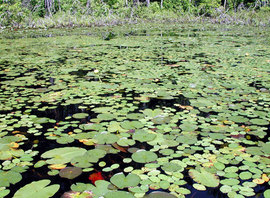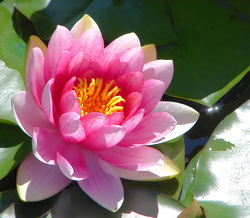Vegetation in Freshwater Biomes

Factors that Affect Freshwater Vegetation:
Depth, rate of flow, temperature and quality of water are all characteristics that affect freshwater biome plants (W3). Sunlight is an essential factor which supports life of freshwater biome plants (W3).
Figure #1: Lily pads are often found floating on shallow lakes or ponds.
(Image source: http://www.townepond.net/images/LilyPads2.jpg)
In streams and rivers vegetation is usually found along the edge of the water. Common species include stargrass, tape grass, and coontails. Streams and rivers will often support trees such as willows, river birch, and cottonwoods. These trees tend to grow in shallow water, where water flow is slow (W3).
In wetlands such as ditches, swamps, marshes, and bogs, the water is saturated throughout the year. This means the dirt holds in as much water as possible, and creates mud. Common plants are cattails, and duckweed. Some trees include cypress, black spruce, and tamarack (W3).
It is harder for lakes and ponds to support large communities of vegetation because of their great depth. The plants found here normally consist of grasses, and weeds. Sometimes plants like cattails, and lily pads (refer to figure 1) can be found floating in shallow lakes and ponds (W3).

Water Lilies:
Seed Dispersal: The flower of the water lily (refer to figure 2) makes a fruit that floats in the water and then drops down to the bottom of the body of water. Here it takes root and the new plant will grow (W6).
Adaptations: Water lilies have stomata that are open most of the time, because water is in great capacity so there is no need for it to be retained in the plant. In result guard cells on the plant are genrally inactive. They also have an increased number of stomata.
They have flat leafs and air sacs to help with flotation. The have specialized roots to take in oxygen (W10).
Figure #2: The water lily flower
plays a key role in seed dispersal.
(Image source: http://2.bp.blogspot.com/-77FdtZHyc_k/Tdh7n2VhSOI/AAAAAAAADpM/PFun_qVl4AY/s1600/Pink_water_lily.jpg)
Defence Mechanism: The plant provides protection for small aquatic creatures. These creatures attack predators that would harm the plant (W6).
Seed Dispersal: The flower of the water lily (refer to figure 2) makes a fruit that floats in the water and then drops down to the bottom of the body of water. Here it takes root and the new plant will grow (W6).
Adaptations: Water lilies have stomata that are open most of the time, because water is in great capacity so there is no need for it to be retained in the plant. In result guard cells on the plant are genrally inactive. They also have an increased number of stomata.
They have flat leafs and air sacs to help with flotation. The have specialized roots to take in oxygen (W10).
Figure #2: The water lily flower
plays a key role in seed dispersal.
(Image source: http://2.bp.blogspot.com/-77FdtZHyc_k/Tdh7n2VhSOI/AAAAAAAADpM/PFun_qVl4AY/s1600/Pink_water_lily.jpg)
Defence Mechanism: The plant provides protection for small aquatic creatures. These creatures attack predators that would harm the plant (W6).

Phytoplankton:
Seed Dispersal: The phytoplankton parent organism makes a carbon copy of itself. This is either done by simple cell division, or by spores that grow inside the parent organism. The spores are released into the water, and then grow, and develop into an adult phytoplankton (W4).
Adaptations: Phytoplankton do not require true leaves, stems, or roots like most plants. This is because they absorb water and nutrients directly from the environment. Phytoplankton have developed many pores, spines, and other projections (refer to figure 3) that increase surface area, absorb nutrients, and increase exposure of sunlight for photosynthesis (W5).
Figure #3: The phytoplankton
has many different pores, spines,
and other projections.
(Image source: http://www.saltwatermasters.com/articles/images/13/phytoplankton.jpg)
Defence Mechanism: Phytoplankton has the ability to change shape in order to protect itself from predators (W11).
Seed Dispersal: The phytoplankton parent organism makes a carbon copy of itself. This is either done by simple cell division, or by spores that grow inside the parent organism. The spores are released into the water, and then grow, and develop into an adult phytoplankton (W4).
Adaptations: Phytoplankton do not require true leaves, stems, or roots like most plants. This is because they absorb water and nutrients directly from the environment. Phytoplankton have developed many pores, spines, and other projections (refer to figure 3) that increase surface area, absorb nutrients, and increase exposure of sunlight for photosynthesis (W5).
Figure #3: The phytoplankton
has many different pores, spines,
and other projections.
(Image source: http://www.saltwatermasters.com/articles/images/13/phytoplankton.jpg)
Defence Mechanism: Phytoplankton has the ability to change shape in order to protect itself from predators (W11).
Human Uses:
Plants from freshwater biomes are commonly used for human products. These include medicine, and cosmetics.
Water Lilies: Mashed roots are often used as an ailment for swollen limbs. They are also used to cure mouth sores, help with digestive problems, and problems of the womb (W6).
Seaweed: Seaweed is used in many cosmetics, skin care products, human food, and drugs (W8).
Algae: Algae is used as a energy source, fertilizer, nutrients and a method of pollution control (W7).
Plants from freshwater biomes are commonly used for human products. These include medicine, and cosmetics.
Water Lilies: Mashed roots are often used as an ailment for swollen limbs. They are also used to cure mouth sores, help with digestive problems, and problems of the womb (W6).
Seaweed: Seaweed is used in many cosmetics, skin care products, human food, and drugs (W8).
Algae: Algae is used as a energy source, fertilizer, nutrients and a method of pollution control (W7).
